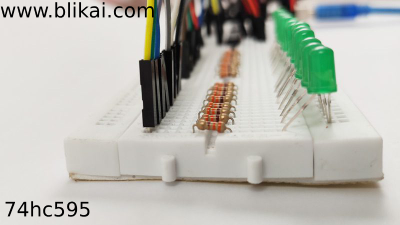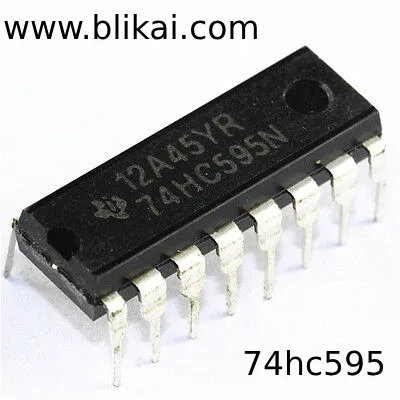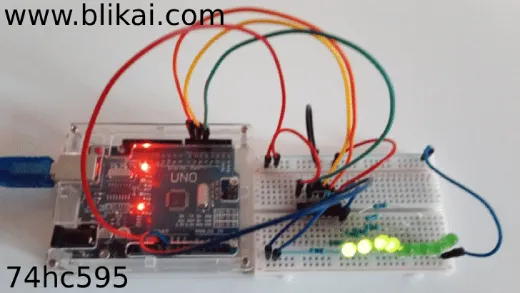74HC595: How Does it Simplify Serial-to-Parallel Conversion?
I. Introduction
The cornerstone of digital electronics lies in the 74HC595 shift register, providing an efficient method to convert sequential data into parallel outputs. This component holds significant importance across various applications by enabling the control of multiple outputs using minimal contacts on microcontrollers or other control devices.
II. Understanding the 74HC595
A. Description and Pinout of the 74HC595 IC
The 74HC595 is an 8-bit serial-in, parallel-out shift register IC commonly used in digital electronics for expanding the number of output pins on a microcontroller or other digital circuit. Here's the pinout:

- VCC: Power supply voltage.
- GND: Ground.
- QA-QH': Output pins.
- SER: Serial data input pin. Data is shifted into the register on the rising edge of the SRCLK.
- RCLK: Register clock input. This signal latches the data from the shift register to the output register on its rising edge.
- SRCLK: Serial clock input. This clock signal controls the shifting of data into the shift register.
- OE: Output enable. When LOW, the outputs are enabled. When HIGH, the outputs are in a high-impedance state (tri-state).
- SRCLR: Serial clear. When activated (typically LOW), it clears the shift register and resets all outputs to LOW.
The QH' pin is the serial output, which allows chaining multiple 74HC595s together to extend the number of outputs. When chaining multiple 74HC595s, the QH' pin of one IC is connected to the SER pin of the next IC.
B. Operating Principle of the 74HC595 for Serial-to-Parallel Conversion
1. Serial Input (SER): The 74HC595 features a single pin for serial input (SER), which is used to enter data. Usually by the use of a microcontroller or other digital device, the data is sequentially and bit by bit fed into the shift register.
2. Serial Clock (SRCLK): Data shifting is managed by the shift register's internal clock. The speed at which data is shifted into the register is determined by this clock input, SRCLK. A discrete quantity of data is shifted into the shift register by the rising edge of this clock signal from the SER pointer.
3. Storage Register and Latch (RCLK): There is an internal memory register in the 74HC595. This register is used to temporarily hold data that is shifted to the shift register. Data is moved from the shift register to the storage register via the RCLK (Register Clock) input. The data in the shift register is latched onto the register and made available through the output pins when the RCLK signal becomes high, which is typically increasing.
4. Parallel Output (QA-QH'): Separate data bits stored in the storage register are represented by the parallel outputs QA-QH'. Every output is a bit of data, where the most significant bit (MSB) is represented by QH' and the least significant bit (LSB) by QA. The data is concurrently available on all output lines when it is latching in the storage register.
5. Output Enable (OE): Outputs can be enabled or disabled via the OE pin. The outputs represent the data stored in the storage register when the OE pin is low, indicating that they are enabled. As the outputs are in a high-impedance condition (three states) when the OE pin is high, they are essentially isolated from external circuits.
6. Serial Clear (SRCLR): You can reset all outputs to the LOW state and clear the contents of the shift register using the SRCLR pin. This pin is normally active-low, meaning that when it is low, the register is cleared.
III. Applications of the 74HC595
1. LED Matrix Displays: The 74HC595 finds expansive operation in controlling LED matrix displays, a popular use case. By chaining multiple 74HC595 chips together, a microcontroller with limited affair legs can efficiently manage a large array of LEDs.
2. Seven-Segment Displays: Similarly, the 74HC595 facilitates the control of multiple seven- member displays, generally employed for numeric and alphanumeric character representation.
3. Controlling Relays: In robotization and control systems, relays play a vital part in managing high- power bias. The 74HC595 is complete at controlling relays, contributing to effective robotization results.
4. Driving LCD Displays: To control individual segments or letters on LCD displays, a large number of contacts are needed. The 74HC595 can help you interface an LCD panel more efficiently by lowering the number of contacts needed.
5. Multiplexing Inputs: Utilizing a shift register allows for effective expansion of the number of inputs a microcontroller can monitor. By scanning over multiple inputs, the 74HC595 enhances input monitoring capabilities efficiently.
6. Shift Register Memory Expansion: In certain scenarios, the 74HC595 serves to expand the memory capacity of microcontrollers or digital devices. Leveraging the shift register as supplementary storage space enables seamless data storage and retrieval operations.
7. Driving Addressable LEDs (RGB LEDs): Precision in timing and control signals is critical for addressable RGB LEDs like WS2812B or APA102. To streamline control with minimal contacts, the 74HC595 collaborates with a microcontroller to efficiently manage numerous addressable LEDs.
8. Cascading Multiple ICs: A key feature of the 74HC595 is its ability to cascade multiple integrated circuits (ICs), facilitating virtually limitless expansion of output pins. This feature is invaluable for applications such as multiplexed input systems or LED displays requiring numerous outputs.

IV. Advantages of the 74HC595
1. Output Expansion: Among the primary advantages of the 74HC595 is its capability to expand the number of output pins on microcontrollers or other digital devices. Through a sequential-parallel design, a single 74HC595 significantly increases the available output pins, enabling control over a larger array of devices or components.
2. Reduced Pin Usage: This helps lower the total number of contacts needed from a microcontroller or other control device because the 74HC595 only needs a few control pins (serial input, clock, latch, etc.) to control numerous output pins. By doing this, important GPIO pins are preserved for future usage and hardware design is made simpler.
3. Cascade Capability: Because of the 74HC595's inherent capacity to cascade several integrated circuits, the output connections can be extended virtually endlessly. Its excellent scalability allows sophisticated applications that need a lot of outputs to be completed without adding a lot of extra complexity.
4. Ease of Use: The 74HC595 is easy to integrate into a design all you need to know is the fundamentals of timing and periodical dispatches. Indeed for those who aren't endured with digital electronics, its standard pinout and well- proved capabilities make it simple to integrate into a range of designs.

5. Wide Availability: Thanks to its wide operation and vacuity, sourcing the 74HC595 from electronics suppliers is royal. Its fashionability ensures abundant attestation, tutorials, and community support, inestimable for literacy and troubleshooting.
6. Low Cost: Offering significant functionality at a modest price point, the 74HC595 presents a cost-effective result for expanding labors. Its affordability renders it suitable for a different range of operations, from recreational to educational trials.
7. Versatility: While primarily employed for sequence-to-parallel conversion and output expansion, the 74HC595 showcases versatility by extending its utility to tasks like multiplexing inputs, motor control, and driving LED displays. Its adaptability makes it a fundamental component in various digital electronics applications.
8. Low Power Consumption: Featuring low power consumption, the 74HC595 is well-suited for energy-efficient or battery-powered applications where conserving energy is paramount. Its ability to operate with minimal power consumption enhances its suitability for such applications.
V. Practical Examples and Circuits
A. Designing a Cascaded 74HC595 Setup for Expanded Outputs
Increasing the number of accessible outputs by designing a cascade system is one useful application of the 74HC595 shift register. Daisy-chaining, or connecting several 74HC595 ICs in series, allows you to drive a lot of output contacts using just a few microcontroller contacts. The available outputs are essentially multiplied by eight for each additional IC added by the additional 74HC595 in the daisy-chain, which yields an additional eight outputs. Because of its scalability and design flexibility, this topology is commonly employed in projects that require for control of several LEDs, relays, or other digital components.
B. Building a Simple LED Display Circuit Using the 74HC595
Building a straightforward LED display circuit with the 74HC595 shift register is another useful example. In this setup, a matrix of LEDs or another layout is controlled by the shift register. Sequence data can be sequentially updated by the microcontroller to the 74HC595 to update the LED statuses and create patterns, numbers, or letters on the display. This method works well for applications with constrained I/O resources since it lowers the number of microcontroller pins needed to directly control the LEDs. Digital clocks, scoreboards, and signage frequently use LED displays, proving the 74HC595's adaptability and value in a range of applications.

VI. Conclusion
In conclusion, a key component in streamlining sequence-to-parallel conversion in digital electronics is the 74HC595 shift register. Microcontrollers may operate many digital components with few I/O contacts by effectively translating sequence data into parallel outputs. Its cascading capacity and ease of use make it a vital and adaptable part in a range of projects requiring many outputs. The 74HC595 improves the efficiency and versatility of digital design by streamlining the interface between microcontrollers and peripherals, whether it is utilized in LED displays, relay control systems, or other applications.
What are Buzzers & How they work?
What Low Pass Filter Is and How It works
Exploring Electronic Components(Guide)
The Transmission System and Its Function
Human-Machine Interface(HMI) Technology [Explained]
Digital Comparator and Magnitude Comparator Guide
What is Flash Memory? [Comprehensive Guide]
IRF540N MOSFET :Principle and Pinout
Exploring Electronic Components: Innovations and Applications
Top 10 Common Electronic Components Guide










